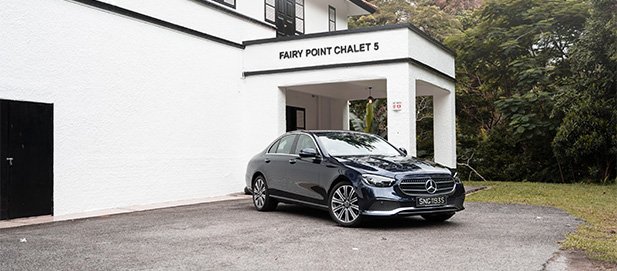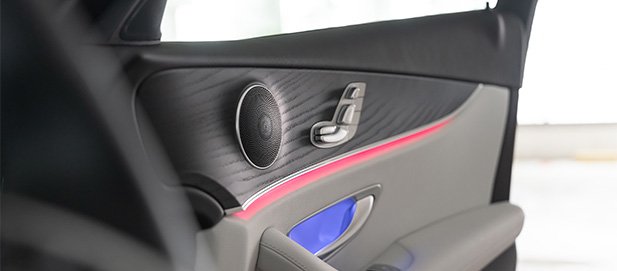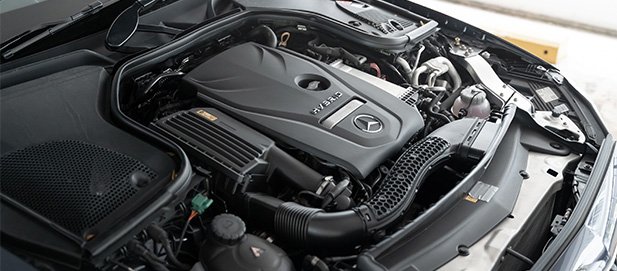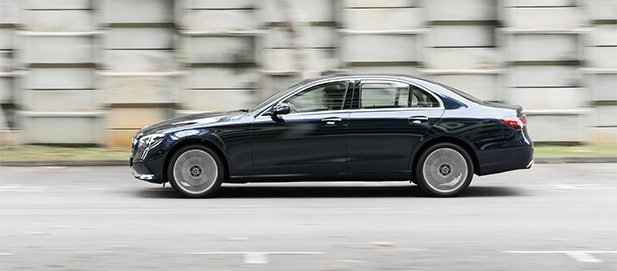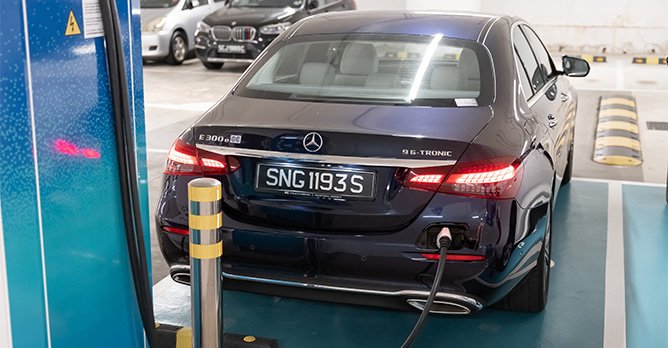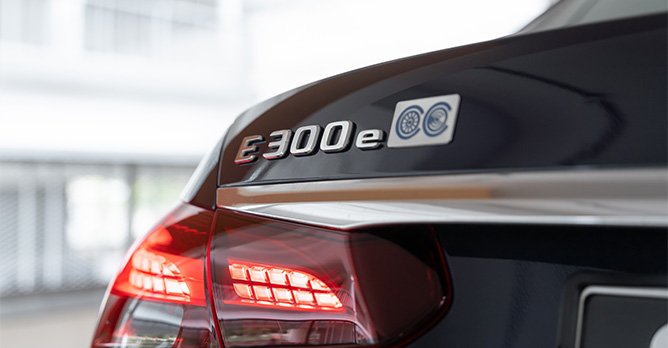Mercedes-Benz E-Class Saloon Plug-in Hybrid E300e Avantgarde (A) Facelift Review
03 Sep 2022|18,160 views
Facelift (What's New)
Boosted combined performance of 315bhp and 700Nm of torque
Exterior styling tweaks, in line with the model's mid-life facelift and Avantgarde-trim
Likewise, interior updates including latest steering wheel and fresher MBUX interface
13.5 kWh (rather than 6.2kWh) battery with up to 44km of range
Does an automotive world adapting to the pressure of zero-emissions still have space for anything other than full electrification?
In the vast, all-encompassing universe of the Three-Pointed Star, this question is not just relevant because the EQS flagship is now in full sail.
Rather, it's relevant because of its cars that are still trying to straddle the future and the present (or past). Cars like this E-Class, which has not just one, but two 'e's (the second one in lowercase): A plug-in hybrid that dispenses with the mildness astrew in the market of late.
Correct me if I'm wrong, but… it looks exactly like an ordinary E-Class.
That's because it does. Apart from hosting another tiny letter in its chrome badge, the E300e follows the E-Class' mid-life facelift to a T (the original plug-in hybrid was the E350e).
Unlike the regal E200 Exclusive we previously drove, the sedan here is specced in the Avantgarde trim - complete with the large, gloss-black star on the grille and protruding power domes on the bonnet.
But the E200 Avantgarde exists, so for the most immediate method of differentiation, cast your gaze downwards. 10-spoke 19-inch alloys, rather than the former's 18-inchers, lend extra presence and grandeur to the E300e, and these are exclusive to the variant. Even the E200 AMG Line doesn't get them.
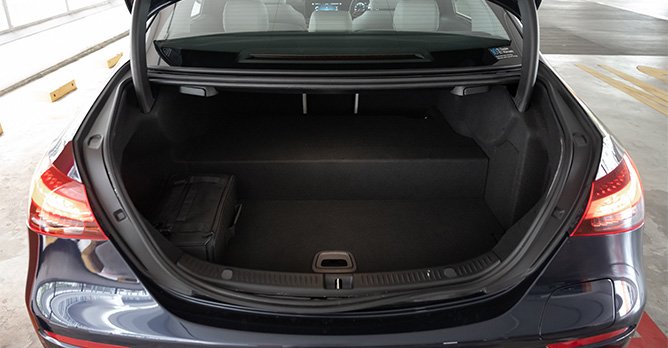
A full charge, taking up to one-and-half hours, should return close to 40km of all-electric range in the real world. That objectively won't take you very far, but this limitation is easy to overlook (we'll explain more in a bit).
Since Singaporean drivers tend to prefer reversing into a lot, the rear placement of the port works perfectly; we never had to struggle with cable length when plugging the car in. But pop the trunk open and one of the largest drawbacks of the hybrid system will show: Boot capacity is down by 170 litres to create space for the battery. Having said that, the 370 litres that remain and its large opening are still highly usable.
And are there any extra green bits on the inside to remind you of the car's electrification?
On the surface, not at all.
As expected of an E-Class, the E300e invites you to luxuriate in its well-put together cabin with the same strengths found in Merc's mid-tier (plentiful soft touch materials, well-supported adjustable seats, lots of button-based automation, and an expansive MBUX infotainment system), although also same weaknesses (not the most intuitive operating of the latter even through the latest-gen touchpad and steering wheel).
While there are no physical 'green' accents to remind you of the car's hybridisation, you do get open pore black ash wood for the car's dash and door panels (as standard in Avantgarde-trim). This offers a welcome variation of visual and tactile texture to the copious glossiness that has come to define Merc interiors.
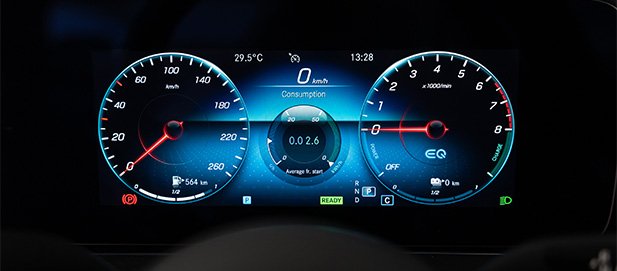
While the E300e gets the standard, pleasing dual-screens for the driver's display and central touchscreen (both 10.25-inches here - not 12.3), the letters 'EQ', glowing in blue, are lodged permanently at the heart of the digital tachometer. Likewise, an entire EQ sub-menu on the central touchscreen allows you to peek into the workings of the car's hybrid system.
Generally intuitive, the manner in which all this additional information is presented is hard to fault.
The E300e's lithium-ion battery, for context, always retains some residual power regardless of its state-of-charge for moving off or creeping at low speeds. Its regenerative brakes are permanently on the hunt too for any energy they can possibly reclaim.
To feed this data to you, the usual limits of the tachometer are nicely book-ended now on the left and right respectively with the level of power utilised by the electric motor and the amount of charge getting put back into the car.
Clicking on 'Energy Flow' will also show you a 'live feed' of whether the car is coasting, recharging its battery while on the move, or using pure electric power. The graphics are colourful, crisp and easy to understand, and the system as a whole feels befitting of how an E-Class would integrate a hybrid set-up.
Right. The most important bit - how significantly does the extra motor change the sedan on the move?
Although the E300e uses the same turbocharged 2.0-litre engine as the discontinued E350e, its new electric motor is significantly stronger, producing 33bhp more than before. Combined power output has thus been bumped to 315bhp and 700Nm of torque, easily extending the PHEV's lead as the most powerful of the non-AMG E-Classes.
This is instantly one of the E300e's most prominent strengths. Merc claims zero to 100km/h will take just 5.4 seconds, and while the timing may be achieved only in 'Sport' or 'Electric', you won't actually need to put the car into these modes to get a sensing of how quickly it can take off.
Floor the accelerator even in 'Comfort' or 'Eco', and the on-paper performance figures will leap to life as the 'Power' bar rapidly fills up and the sedan glides forth. There is just the slightest jerk (and naturally, some noise) when the engine kicks in, but thereafter, gear changes are near imperceptible thanks to Merc's super-smooth 9G-Tronic transmission.
Nonetheless, there's no mistaking this as a mid-sized luxury saloon - and one from Merc. Darting in and out of traffic has never felt in the E-Class' nature, and the E300e still feels more in its element swallowing up both kilometres and road imperfections on Lane 1 at rapid pace, while maintaining a remarkable sense of quiet inside.
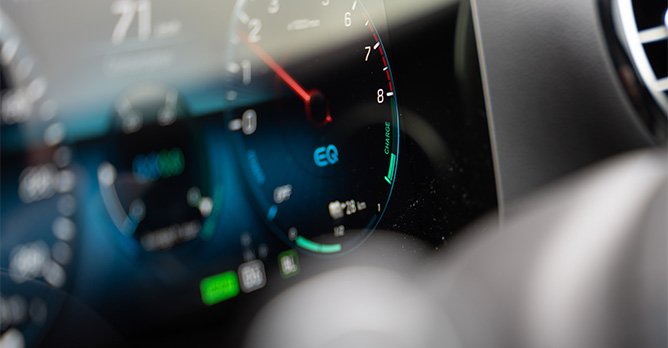
We tried, but it doesn't seem that they can be deactivated and the unexpected deceleration does require some behavioural changes for one's right foot. But by day four with the car, we'd largely gotten used to it.
The other most apparent difference is at low speeds. As mentioned earlier, in carparks and start-stop traffic along the KPE at 8:00am, the E300e serenely rolls along on pure electric power. This extra facet of silent composure coheres perfectly not just with its well-damped suspension, but more importantly, with the general aura of unflappability that defines an E-Class.
The value today of a plug-in hybrid E-Class…?
The plug-in hybrid, as a 'lukewarm' midway-point, has felt difficult to defend for a long time. In fact, you'd be forgiven for thinking of the idea as merely a green virtue signal if we were still living in 2012.
But 2022 is a different sort of era. As the authorities continue coming down hard on emissions, the number of charging points islandwide is steadily going up. (Meanwhile, it seems that pump prices cannot decide on which direction they want to move in.)
It'd be remiss not to note that although the golden consumption figure of 20+km/L is easily within reach if the E300e's battery is charged, we only squeezed out 13.2km/L when it was in its default 0-1% state. So sure - forget the supposedly tree-hugging suggestion that the lowercase 'e' puts forth if you must; the Lexus ES 300h is arguably better at the magic of petrol tank-stretching, and doesn't even require you to plug in.
But return your attention to the original 'E' - as in capital E-Class. There's no doubt that the E300e's one-two petrol engine/electric motor configuration understands Merc's time-resistant executive sedan formula, and coaxes more out of it with added power and refinement.
Some may point out that the EQE, Merc's answer to what a - hold your breath - bespoke, all-electric, mid-sized luxury experience should look like is just on the horizon.
We'd argue, however, that the E-Class' ability to remain unmistakeable and poised after all this time will no doubt still hold broader appeal for some years to come.
Above all, there's the fact that the E300e is currently the entry point to the E-Class range - a surprising feat that's surely been helped by its A2 VES band (the E200 is penalised in C1). While the towkays linger on the question if full electrification is the way forward, they can surely afford to take this (small) electric motor as an added vessel of either efficiency, refinement, or power - or all of the above - for now.
Here's what we had to say about the facelifted Mercedes-Benz E200 Exclusive!
And if you're considering other executive sedans, be sure to check out the E300e's slightly different competitors here:
The Lexus ES300h Hybrid is a luxurious sedan that scores high on space and comfort
With its mild hybridisation and new tech, the facelifted BMW 5 Series continues to deliver sublime luxury
Want to see this Mercedes-Benz E300e's 700Nm of torque in action? Catch us in out video review here!
Facelift (What's New)
Boosted combined performance of 315bhp and 700Nm of torque
Exterior styling tweaks, in line with the model's mid-life facelift and Avantgarde-trim
Likewise, interior updates including latest steering wheel and fresher MBUX interface
13.5 kWh (rather than 6.2kWh) battery with up to 44km of range
Does an automotive world adapting to the pressure of zero-emissions still have space for anything other than full electrification?
In the vast, all-encompassing universe of the Three-Pointed Star, this question is not just relevant because the EQS flagship is now in full sail.
Rather, it's relevant because of its cars that are still trying to straddle the future and the present (or past). Cars like this E-Class, which has not just one, but two 'e's (the second one in lowercase): A plug-in hybrid that dispenses with the mildness astrew in the market of late.
Correct me if I'm wrong, but… it looks exactly like an ordinary E-Class.
That's because it does. Apart from hosting another tiny letter in its chrome badge, the E300e follows the E-Class' mid-life facelift to a T (the original plug-in hybrid was the E350e).
Unlike the regal E200 Exclusive we previously drove, the sedan here is specced in the Avantgarde trim - complete with the large, gloss-black star on the grille and protruding power domes on the bonnet.
But the E200 Avantgarde exists, so for the most immediate method of differentiation, cast your gaze downwards. 10-spoke 19-inch alloys, rather than the former's 18-inchers, lend extra presence and grandeur to the E300e, and these are exclusive to the variant. Even the E200 AMG Line doesn't get them.

A full charge, taking up to one-and-half hours, should return close to 40km of all-electric range in the real world. That objectively won't take you very far, but this limitation is easy to overlook (we'll explain more in a bit).
Since Singaporean drivers tend to prefer reversing into a lot, the rear placement of the port works perfectly; we never had to struggle with cable length when plugging the car in. But pop the trunk open and one of the largest drawbacks of the hybrid system will show: Boot capacity is down by 170 litres to create space for the battery. Having said that, the 370 litres that remain and its large opening are still highly usable.
And are there any extra green bits on the inside to remind you of the car's electrification?
On the surface, not at all.
As expected of an E-Class, the E300e invites you to luxuriate in its well-put together cabin with the same strengths found in Merc's mid-tier (plentiful soft touch materials, well-supported adjustable seats, lots of button-based automation, and an expansive MBUX infotainment system), although also same weaknesses (not the most intuitive operating of the latter even through the latest-gen touchpad and steering wheel).
While there are no physical 'green' accents to remind you of the car's hybridisation, you do get open pore black ash wood for the car's dash and door panels (as standard in Avantgarde-trim). This offers a welcome variation of visual and tactile texture to the copious glossiness that has come to define Merc interiors.

While the E300e gets the standard, pleasing dual-screens for the driver's display and central touchscreen (both 10.25-inches here - not 12.3), the letters 'EQ', glowing in blue, are lodged permanently at the heart of the digital tachometer. Likewise, an entire EQ sub-menu on the central touchscreen allows you to peek into the workings of the car's hybrid system.
Generally intuitive, the manner in which all this additional information is presented is hard to fault.
The E300e's lithium-ion battery, for context, always retains some residual power regardless of its state-of-charge for moving off or creeping at low speeds. Its regenerative brakes are permanently on the hunt too for any energy they can possibly reclaim.
To feed this data to you, the usual limits of the tachometer are nicely book-ended now on the left and right respectively with the level of power utilised by the electric motor and the amount of charge getting put back into the car.
Clicking on 'Energy Flow' will also show you a 'live feed' of whether the car is coasting, recharging its battery while on the move, or using pure electric power. The graphics are colourful, crisp and easy to understand, and the system as a whole feels befitting of how an E-Class would integrate a hybrid set-up.
Right. The most important bit - how significantly does the extra motor change the sedan on the move?
Although the E300e uses the same turbocharged 2.0-litre engine as the discontinued E350e, its new electric motor is significantly stronger, producing 33bhp more than before. Combined power output has thus been bumped to 315bhp and 700Nm of torque, easily extending the PHEV's lead as the most powerful of the non-AMG E-Classes.
This is instantly one of the E300e's most prominent strengths. Merc claims zero to 100km/h will take just 5.4 seconds, and while the timing may be achieved only in 'Sport' or 'Electric', you won't actually need to put the car into these modes to get a sensing of how quickly it can take off.
Floor the accelerator even in 'Comfort' or 'Eco', and the on-paper performance figures will leap to life as the 'Power' bar rapidly fills up and the sedan glides forth. There is just the slightest jerk (and naturally, some noise) when the engine kicks in, but thereafter, gear changes are near imperceptible thanks to Merc's super-smooth 9G-Tronic transmission.
Nonetheless, there's no mistaking this as a mid-sized luxury saloon - and one from Merc. Darting in and out of traffic has never felt in the E-Class' nature, and the E300e still feels more in its element swallowing up both kilometres and road imperfections on Lane 1 at rapid pace, while maintaining a remarkable sense of quiet inside.

We tried, but it doesn't seem that they can be deactivated and the unexpected deceleration does require some behavioural changes for one's right foot. But by day four with the car, we'd largely gotten used to it.
The other most apparent difference is at low speeds. As mentioned earlier, in carparks and start-stop traffic along the KPE at 8:00am, the E300e serenely rolls along on pure electric power. This extra facet of silent composure coheres perfectly not just with its well-damped suspension, but more importantly, with the general aura of unflappability that defines an E-Class.
The value today of a plug-in hybrid E-Class…?
The plug-in hybrid, as a 'lukewarm' midway-point, has felt difficult to defend for a long time. In fact, you'd be forgiven for thinking of the idea as merely a green virtue signal if we were still living in 2012.
But 2022 is a different sort of era. As the authorities continue coming down hard on emissions, the number of charging points islandwide is steadily going up. (Meanwhile, it seems that pump prices cannot decide on which direction they want to move in.)
It'd be remiss not to note that although the golden consumption figure of 20+km/L is easily within reach if the E300e's battery is charged, we only squeezed out 13.2km/L when it was in its default 0-1% state. So sure - forget the supposedly tree-hugging suggestion that the lowercase 'e' puts forth if you must; the Lexus ES 300h is arguably better at the magic of petrol tank-stretching, and doesn't even require you to plug in.
But return your attention to the original 'E' - as in capital E-Class. There's no doubt that the E300e's one-two petrol engine/electric motor configuration understands Merc's time-resistant executive sedan formula, and coaxes more out of it with added power and refinement.
Some may point out that the EQE, Merc's answer to what a - hold your breath - bespoke, all-electric, mid-sized luxury experience should look like is just on the horizon.
We'd argue, however, that the E-Class' ability to remain unmistakeable and poised after all this time will no doubt still hold broader appeal for some years to come.
Above all, there's the fact that the E300e is currently the entry point to the E-Class range - a surprising feat that's surely been helped by its A2 VES band (the E200 is penalised in C1). While the towkays linger on the question if full electrification is the way forward, they can surely afford to take this (small) electric motor as an added vessel of either efficiency, refinement, or power - or all of the above - for now.
Here's what we had to say about the facelifted Mercedes-Benz E200 Exclusive!
And if you're considering other executive sedans, be sure to check out the E300e's slightly different competitors here:
The Lexus ES300h Hybrid is a luxurious sedan that scores high on space and comfort
With its mild hybridisation and new tech, the facelifted BMW 5 Series continues to deliver sublime luxury
Want to see this Mercedes-Benz E300e's 700Nm of torque in action? Catch us in out video review here!
Car Information
Mercedes-Benz E-Class Saloon Plug-in Hybrid E300e Avantgarde (A)
CAT B|Petrol-Electric|43.5km/L
Horsepower
235kW (315 bhp)
Torque
700 Nm
Acceleration
5.8sec (0-100km /hr)
This model is no longer being sold by local distributor
All Used Mercedes-Benz E-Class Saloon Plug-in HybridThank You For Your Subscription.





















































